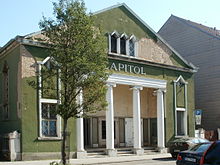Capitol Schwetzingen
The Capitol Schwetzingen is a former cinema in Schwetzingen . It is located in the center of the city and has not been used since 1976. In April 2009, the monument office classified the building as “not completely preservable”.
Location and architecture
The elongated building, erected almost in an east-west direction, with the residential wing attached to the center to the north, has its formative portal to Herzogstraße to the west. Mühlenstrasse (L543a), which functions as a ramp to the Carl-Theodor-Brücke in this area and which borders the area between Dreikönigstrasse and Carl-Theodor-Strasse to the east and makes the ensemble appear marginal, runs at a half-height at the rear. The condition of the building is deplorable. The roof and windows seem tight, but the plaster is crumbling and the vegetation all around is getting out of hand. Despite everything, the representative structure still has a “heroic character”.
The building was built by Johannes Helfrich from Plankstadt with 600 seats and opened on October 8, 1926 with the box office hit “Die Försterchristl” with Lya Mara in the lead role. The architect was government builder Hodel from Mannheim.
After entering the building through the classical, open pillared hall decorated with Ionic columns , the visitor came to the spacious staircase hall with the cash desks arranged on the side. The outside stairs led to the upper tier on both sides . The tiers were designed like individual boxes and each had eight armchairs with a small table in the middle. This intimate seating arrangement was sacrificed for a higher number of seats after the war. The foyer also had a cloakroom on one side of the room and a kiosk on the other.
The actual theater hall was contemporary described as modern and elegant, but also as spacious. The slightly corrugated ceiling was painted with vegetal decorations. The cinema was equipped to a high standard and has an orchestra pit , and there was a tuning room for the musicians. In addition to a low-pressure heating system, ventilation is also highlighted, which provided air exchange several times an hour. Between the orchestra pit and the screen there is a speaking platform with an adjacent cloakroom, which could also be used for smaller artistic performances.
history
Cinema history Schwetzingen
After the city's first cinema, the NT-Lichtspiele in Friedrichstraße 4a, had already started operations in 1911, Helfrich joined his sensationally large cinema in 1926. NT-Lichtspiele converted their capacity to 351 seats; more was not possible there due to the cramped building conditions. In the 1950s and 60s there were four cinemas in Schwetzingen before the first one, the NT-Lichtspiele, surrendered. A few months before the Capitol, the Rex-Kino, which opened in 1953 on Clementine-Bassermann-Strasse, also ceased operations; the building was demolished in 1985. The only house in Schwetzingen that is still used today is Luxor, also opened in 1953 by Emil Helfrich, son of Johannes Helfrich († 1940).
Building history
The cinema building, which has a usable area of 650 m 2 , stands on a good 850 m 2 property that was previously used as a gymnasium. The cinema was extensively renovated for the 25th anniversary. The bases were Zebrano disguised -Furnier and painted above golden. A new stage curtain was given the same color. The pilaster strips of the balconies were coated with gold leaf, the boxes mahogany veneer . The original green Terranova exterior plaster has survived the decades, but has partially flaked off. Part of the house has sunk; there are cracks. A check of the statics is still pending.
After it was closed in 1976, the house was no longer used. A concrete false ceiling was installed over almost the entire length of the large hall; the full height of the room is only visible today in the area of the screen. Parts of the building include a sauna with a bar and a restaurant. Today, as of the beginning of 2015, both the main building and the residential building have been completely empty for several years. The city of Schwetzingen acquired the building in March 2015. In 2006 it had refused to buy it, with reference to tight urban finances.
Individual evidence
- ↑ Schwetzinger Zeitung of March 9, 2010: Sybille M. Derr: Former jewel in the deep sleep
- ↑ Interim report on the redevelopment area Herzogstrasse / Schlossplatz. Minutes of the municipal council meeting of July 17, 2013, Top 12. Available online on the website of the city of Schwetzingen, PDF file, 316kB
- ↑ General plan of redevelopment areas ( Memento of the original of July 14, 2014 in the Internet Archive ) Info: The archive link was automatically inserted and not yet checked. Please check the original and archive link according to the instructions and then remove this notice. , As of July 2010 on the website of the city of Schwetzingen, PDF, 510kB, accessed on July 5, 2014
- ^ Opening report from the special supplement of the Schwetzinger Zeitung for the opening of the Capitol-Lichtspiele on October 8, 1926
- ↑ http://www.steffi-line.de/archiv_text/nost_film20b40/119_peer_heinrich.htm
- ↑ Joachim Kresin: From the flicker box to the modern movie theater
- ↑ Plan of the Schwetzingen building files
- ↑ Allekinos.com Capitol Schwetzingen
- ↑ a b c When the visitors were standing in rows for tickets ... , Schwetzinger Zeitung , online edition of March 9, 2010
- ↑ What will happen to the Capitol? Schwetzinger Zeitung, March 24, 2015, accessed on March 31, 2015
Web links
Coordinates: 49 ° 23 ′ 10.2 " N , 8 ° 34 ′ 31.8" E

